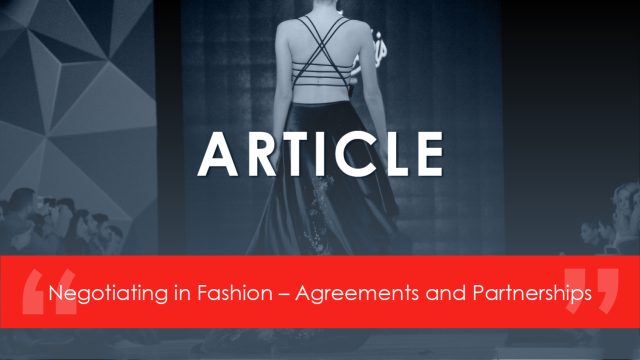
When creating a business, the aim is to make it grow, maximizing results, attracting investors and partners.
If, in a first stage, it is important to be creative and design a business model through which ideas will be implemented in order to obtain economic benefits from them, in a second stage, it is important to define the rules of the game. The basis of any commercial activity, and, therefore, of any business, is always supported by contracts, because it is in these that the conditions delegated by the legislation into the parties’ freedom to negotiate are established, regardless of whether they are labor or commercial relationships.
Being fashion a creative, cross-border sector with a major economic impact worldwide, it is also important to regulate the legal relationships on which it is based, in order to safeguard the quality of the items sold and the prosperity of the business.
Thus, when it comes to economic growth and expanding a business, without prejudice to the provisions of the law, it is written agreements that guide the terms and conditions that result from a negotiation, reducing risks and establishing guarantees. In this sense, it is worth identifying the typical contractual figures that entrepreneurs in the fashion industry can use when attracting business partners.
Once the partners have been chosen, it is up to the parties to negotiate and decide on the partnership model, which is then set out in a written agreement, as follows:
- Memorandum of Understanding – at a negotiating and embryonic stage of the partnership, when objectives and rules are still being defined, the future partners may resort to signing a memorandum of understanding, which will later give rise to a formal agreement, and which may use one of the models listed below.
- Partnership Agreement – in order to operate a joint business, one can choose to establish the terms and conditions of the partnership in a simple written agreement, defining the obligations of each partner and how each will contribute to the business, whether through financial investment or the delivery of goods and services.
- Commercial Distribution Contract – which is a standard contract through which a third party is authorized to place the products or services of the fashion company on the market, in a previously delimited territory, following certain rules. It can be a distribution agreement in the strict sense, but also an agency/commercial representation or franchising
- Supply contract – a model to be adopted if the aim is simply to have goods supplied by a third party, whether raw materials or components for the final product, following strict production criteria and the way in which the goods should be delivered.
- Services Agreement – is a type of contract similar to a partnership agreement, but in which, typically, one of the parties undertakes to provide certain services in exchange for monetary consideration, such as contracts for the production of fashion goods.
- Association in Participation – this is a classic agreement between two companies in which one of them associates itself with the activity of the other.
- Consortium – represents a partnership between two or more parties engaged in an economic activity, who undertake to carry out a certain activity or make a certain contribution in order to carry out preparatory acts for a specific undertaking or an ongoing activity.
- Joint-Venture Contract – stands for an agreement between two parties who intend to pursue a commercial activity jointly, through the provision of services, goods, investment and even the incorporation of a company with a view to developing said activity. Examples include collaborations between two companies that intend to launch a joint collection.
In addition to the contractual models listed above, it is common for partnerships to have the sole aim of raising capital, i.e. financial investment from a third party. To this end, depending on the amounts involved, the guarantees to be provided and whether or not the investor can become a shareholder of the company carrying out the activity, the parties must use contracts for this purpose, such as the convertible loan agreement or Simple Agreement for Future Equity (known as SAFE).
Once the contractual model has been chosen, the written agreement containing the essential terms and conditions of the partnership must be drawn up, without prejudice to the provisions of the applicable legislation for each type of contract mentioned above.
As a final note, it is important to mention that in an industry as competitive as the fashion industry, which has creativity as its pillar, regardless of the type of partnership chosen and the contract adopted, when drafting it, it is extremely important to safeguard the protection of intellectual property rights and know-how.
by Ricardo Cardoso and Carolina Ribeiro Santos, Practice Area – Sports, Fashion and Entertainment



